
Management actions continue throughout the Group to improve profitability and the early benefits are reflected in the 2004 financial results. Headline earnings of R214 million is particularly encouraging as it represents a turnaround of R307 million from the previous year and is an indication of Tongaat-Hulett's potential. Considerable value is being unlocked in the Group with its earnings momentum, its balanced profile of four sizeable, strategically positioned and focused operating companies and its improving investment rating.
Benefits are materialising from the solid platforms created and the substantial investments previously made in each business. A review of the underlying business models of all operations has been undertaken, resulting in actions to optimise capacity utilisation, enhance sales mix, improve raw material procurement, grow volumes and reduce costs. These actions are countering the effect of factors such as the strengthening currency and the small sugar crops harvested in 2003 and 2004.
 |
THE PAST YEAR'S EMPHASIS WAS ON ACTIONS TO GROW EARNINGS RAPIDLY. TONGAAT-HULETT IS ADJUSTING TO THE STRONGER CURRENCY AND IS BUILDING EARNINGS MOMENTUM. THE MIX OF BUSINESSES IN THE GROUP WAS AGAIN A STRENGTH IN 2004. |
 |
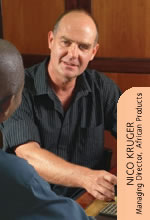 |
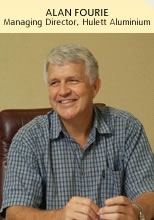 |
 |
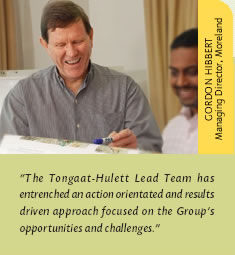 |
 |
 |
 |
On the first page of last year's Annual Report, we clearly set out our comprehensive plan and it is pleasing to report on our progress against those targets.
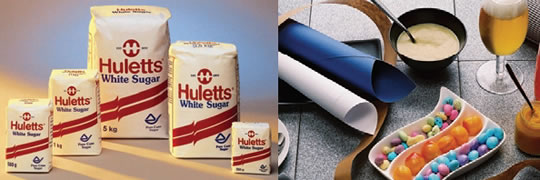


The Group recorded headline earnings of R214 million in 2004, a R307 million improvement from last year. This was generated off revenue of R6,3 billion (2003: R6,6 billion) in a year when the Rand strengthened against the US dollar by 15 percent and with little movement in US dollar selling prices contained in these results.
Operating profit improved to R364 million from R80 million in 2003. Management's profit improvement actions across the Group, which have started taking effect, largely offset the negative effects on underlying operating profit of factors such as the strengthening Rand, high priced maize and the small sugar crops harvested in the last two years. Underlying operating profit is now more affected by these factors while the exposure to valuation adjustments has been reduced. The valuation adjustments charged against income were R347 million less than the prior year. These valuation items relate mainly to the valuation of certain contracts and balance sheet items at the end of the period. The maize futures position reported in the previous year, which was required to be marked to market through the income statement, was eliminated in 2004 and a close-out valuation gain of R18 million realised, compared to the R211 million charge in the previous year.
The Group's share of equity accounted associate company profit increased by R51 million, with a positive contribution from the sugar operations in Mozambique.
Net finance costs were R93 million compared to R152 million in 2003. The main drivers in this reduction were lower interest rates, lower maize finance costs and the benefit of reorganising the funding structure of Mafambisse in Mozambique.
Cash flow before dividends for the year was an inflow of R93 million, an improvement compared to the R206 million outflow in 2003.
The Board has declared a final dividend of 120 cents per share, which brings the total annual dividend to 170 cents per share, a 42 percent increase over 2003.
The balance sheet remains sound with net borrowings as a percentage of equity at 13,2 percent (2003: 13,4 percent) and Tongaat-Hulett remains well positioned to capitalise on the attractive growth and investment opportunities that exist for the Group.
The progress made in 2004 is in line with the ongoing strategy of unlocking earnings growth from the existing platform of four sizeable operating companies. This has been achieved in a challenging business environment.
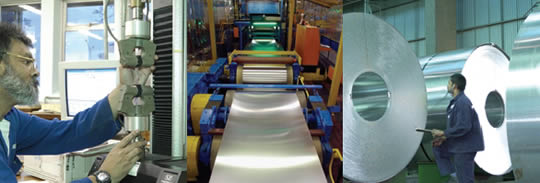
The improved results in the Group's aluminium business have been achieved notwithstanding the impact of the strengthening of the currency. The established base enables the remaining 25 percent of rolled products production capacity to be utilised at significantly higher levels of profitability.
Hulett Aluminium improved its operating profit to R150 million (2003: R5 million), with the Group's share being 50 percent thereof. The focus remains on increasing volumes, improving product mix and reducing unit costs. These factors have together generated financial benefits approaching R450 million in the past two years, and have largely offset the effects of the strengthening Rand. Hulett Aluminium started benefiting at the end of 2004 from rising US dollar rolling margins, especially in North America and Asia.
The ongoing consolidation of the rolled products industry continued in 2004. Alcan concluded its acquisition of Pechiney, the major French based aluminium producer, and subsequently floated the majority of the combined rolled products operations into a new listed company, Novelis. This means that the largest rolled products business in the world is no longer part of a vertically integrated aluminium company and will result in increased focus on the profitability of the global rolled products industry. Alcoa has also contributed to the ongoing consolidation through its acquisition of the rolled products assets of Rusal, the major aluminium producer in Russia.
This consolidation has created opportunities for the relatively few remaining independent aluminium rolled products producers, as end users seek alternative sources of supply. This applies particularly to the high value-added products where there are high barriers to entry. Hulett Aluminium is not market constrained and can comfortably sell its total output. As in many other manufacturing industries, the more profitable aluminium rolled products tend to be those that require more sophisticated plant and process technology, coupled with the ability to meet high quality levels. Hulett Aluminium is applying methodologies and capacity optimisation models to allocate its available capacity to the most profitable product mix, based on matching excess sales opportunities with a flexible manufacturing capability.
Hulett Aluminium supported recent initiatives by a number of downstream customers who have increased their investment in manufacturing capacity. This resulted in robust growth in this market of more than 11 percent in 2004, particularly in the transport, automotive and packaging sectors. Demand for aluminium extrusions in the local market has also been high, particularly for architectural products, leading to an 11 percent growth in extrusion sales volumes.
The international market has been characterised by improved demand. Rolling margins, especially in North America and Asia, improved in the last quarter with encouraging signs of this trend continuing. The strengthening of the Euro and the more sluggish growth in Europe has limited the improvements in the European market, although attractive opportunities exist in selected product lines. The rolled products operation increased export sales by more than 10 percent, with further growth limited by the allocation of production capacity to the growing local market.
Total rolled products sales volumes increased by more than 10 percent to 144 000 tons. Further growth in sales was hampered by reduced output arising from a fire on the Camps Drift hot mill in May 2004 and a four week strike in the second half of the year. The improved manufacturing performance, achieved despite these set backs, was confirmed by the output of 160 000 tons annualised, achieved in the last quarter of 2004. The rolled products operation remains on track to achieve its long term targeted sales volumes of more than 200 000 tons beyond 2006.
In November 2004 the US International Trade Commission (ITC) ruled that heat treated plate exports into the US by Hulett Aluminium had not caused injury to the US aluminium industry, and thus dismissed Alcoa's application for the imposition of an anti-dumping duty. It is pleasing that the ruling by the ITC confirmed Hulett Aluminium's earlier statements that the petition was without merit. The proceedings also confirmed that Hulett Aluminium can compete in established markets as an independent supplier of high quality and profitable niche products with a low cost base compared to its competitors. Numerous approaches from prospective customers were received during the period of the petition.
Hulett Aluminium continues to place major emphasis on achieving a more profitable product mix by growing sales of higher margin and more technically demanding products.
Exports of can end stock, a demanding high strength, thin gauge product, have almost trebled over the last two years, and are expected to again increase significantly over the next two years. Exports of building and painted products have grown by 34 percent in the year, with a number of prestigious projects utilising Hulett Aluminium's sheet, including the roof of the cycling velodrome built for the 2004 Olympic Games in Athens, and the recently completed Beijing Opera House.
Total sales of clad products, a multi-alloy and multi-layered product used primarily in heat exchangers in the automotive industry, have more than trebled in 2004. With the use of heat exchangers growing rapidly, sales volumes of this product are expected to show strong growth.
The ramp-up of production of rolled products has been accompanied by low cost increases in recent years, as the cost base of the plant is fully established, and additional output can be achieved with only marginal increases in costs, with a consequent rapid reduction in unit costs. Conversion costs per ton decreased by 4,9 percent in 2004 as a result of the volume growth and cost savings.
Further output increases in the next three years will see conversion costs per ton decreasing by more than 20 percent in real terms. Savings in costs have been achieved, particularly in recycling costs, with total metal premium and recycling costs per ton decreasing by more than 10 percent in 2004. The opportunity exists and is being targeted to further reduce costs in these and other areas.
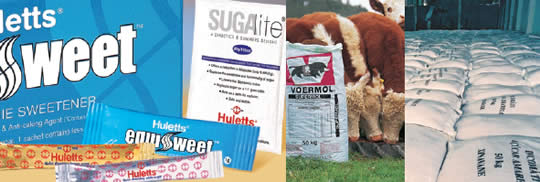
By the end of 2004, solid progress had been made with the new business model. Maize pricing is now in tandem with customer pricing and African Products will continue its turnaround in 2005.
African Products experienced a year of transition, with a move to a new maize procurement and product pricing model, and the commencement of a profit recovery. Operating profit improved to R63 million (2003: loss of R104 million) despite the pressure of the exchange rate on local pricing and export contributions, together with the high priced maize procured under the previous business model. Domestic sales volumes of prime products were 2 percent below those of 2003 as a result of the pressure from imports of starch and glucose in African Products' markets and imports of finished products in its customers' markets.
The maize priced under the previous procurement approach was utilised by the end of October 2004. The maize for all sales thereafter was priced when prime product prices and volumes were agreed with customers. The progress with the adoption of this back-to-back approach resulted in African Products recording a return to profitability during the last quarter of 2004.
Physical maize supply has been delinked from pricing. Maize for physical delivery has been secured up to June 2006. Approximately 54 percent of the maize and non-toll sales for the rest of 2005 are unpriced. The balance has been priced with customers at margins that will contribute to a return to an acceptable level of profitability for African Products in 2005.
African Products' sales to the South African market have suffered under the pressure from imports of both starch and glucose and customers' products with this year's sales being 2 percent below 2003. Following the loss of significant volumes to direct imports, African Products has successfully regained more than half of these volume losses during the last quarter of 2004.
African Products is well placed, with its installed capacity, to benefit from growth in local demand for starch and glucose products. It is encouraging that sales volumes for the last quarter of 2004 were 2,2 percent above the comparative period for 2003. The strong growth being experienced in the South African economy and the underlying strength of demand for starch and glucose indicates the potential for good volume growth in the coming years.
African Products succeeded in exporting some 53 000 tons in 2004, albeit at reduced contributions, and underscores the reputation that it has developed for high quality products in international markets. This was achieved despite exports continuing to experience significant pressure from the strong currency, port congestion and sharply higher international freight rates. It represents approximately 12 percent of African Products' prime product sales.
This year saw a further increase in the movement of starch and glucose around the world. Following the upward movement of prices late in 2003, delivered prices remained relatively stable throughout 2004. Competition out of the East has increased, with China seeing a significant investment in wet-milling capacity. This is expected to be taken up by domestic consumption over the next few years. African Products has been successful in fending off aggressive attacks from foreign competitors, particularly in the last quarter of 2004.
Fixed cash costs in 2004 were again held below 2002 levels. A major restructuring exercise is currently underway, relating to manning levels and skills profiles, to allow African Products to meet the challenges of a highly competitive environment. This exercise will lead to further savings in overhead costs.
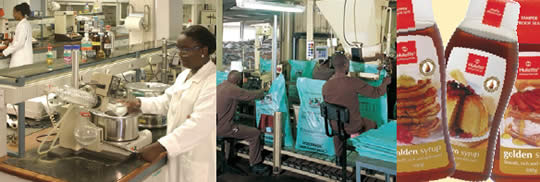
Tongaat-Hulett Sugar has successfully undertaken many earnings enhancing actions in this challenging time. These have already started to take effect and, together with additional initiatives that have been identified, place the business in a strong position moving forward.
Tongaat-Hulett Sugar's profit from operations, before interest, totalled R184 million (2003: R202 million). This includes dividends from Triangle, the equity accounted share of operating profit at Xinavane in Mozambique and is before restructuring costs. The relatively low sugar crop experienced for the second year in a row, together with the decrease in the South African domestic sugar price late in 2003 and the strengthening Rand's effect on export realisations, depressed margins in 2004. The recent substantial increase in the international sugar price has not yet impacted the financial results.
Tongaat-Hulett Sugar has responded proactively to the challenging environment. Actions that have been completed in the South African operations include the closure of the Entumeni mill with the diversion of cane to the Amatikulu mill, the closure of the sugar head office, downsizing of centralised services, the reorganisation of the milling operations from five mill structures to two regional business units and the conclusion of a benchmarking exercise to increase the benefit from the refining value chain. More value is being realised from the Huletts brand and value-added products. After a pilot plant ran successfully for two years, a new refining technology plant has been approved for installation at the Felixton mill. A pilot plant using this technology has also been successfully deployed in Brazil for trials at two sugar mills. Mozambique is one of the important growth areas and has now made a positive contribution to earnings. The benefits of the actions completed and the further substantial actions being taken will flow in future periods.
Total sugar production in 2004 increased to 1,081 million tons, 2,8 percent up on 2003. The total cane crush of 9,4 million tons in 2004 represents 72 percent of installed capacity compared to 71 percent in the 2003 year.
Sugar production in South Africa of 724 000 tons was 11 percent up on the 652 000 tons produced last year but still well down on the 860 000 tons of 2002. The successive sugar crops harvested in the 2003 and 2004 seasons rank amongst the lowest in the last decade and are attributable to poor rainfall in many parts of the cane belt. Tongaat-Hulett's share of the South African Sugar industry production increased from an all time low of 27,1 percent in 2003 to 32,6 percent in 2004.
The drought experienced in Swaziland at the beginning of the season resulted in Tambankulu Estates producing the raw sugar equivalent of approximately 50 000 tons, compared to 54 000 tons in the 2003 season.
The socio-political and economic difficulties of operating in Zimbabwe have continued and Triangle's sugar production decreased to 222 000 tons, 16 percent down on the previous year. The operation has remained profitable and intact and dividends of R51 million (2003: R19 million) were remitted during the year.
In Mozambique the rehabilitation of the Mafambisse and Xinavane sugar estates continued in 2004 with sugar production of 85 000 tons compared to 82 000 tons in the 2003 season. A positive contribution of R23 million to headline earnings was achieved, equating to a turnaround of R88 million.
In terms of installed milling capacity, Tongaat-Hulett Sugar is capable of producing 1,5 million tons of sugar per annum compared to the 1,081 million tons produced in 2004. Plans are in place to continue to optimise capacity utilisation. Cane supplies of an additional 832 000 tons have been identified in South Africa with 618 000 tons already contracted. In Mozambique, the planting of new areas under cane and the maximisation of yields is progressing with the target capacity of 156 000 tons sugar expected within the next four years.
Tongaat-Hulett Sugar's brands performed well in 2004 with Huletts® being voted by an independent survey South Africa's fourth most admired food brand and sixth favourite brand overall measured in terms of awareness as well as trust and confidence.
In South Africa, local market sales at 464 000 tons show a decrease of 7 percent over the prior year and the 7 percent decrease in the price of sugar in October 2003 resulted in a reduction in margins. Stock holdings at December 2004 have increased by 11 percent to 195 000 tons.
Continued progress has been made by sugar producers in Mozambique to secure the domestic market against imports with year-on-year sales by domestic producers growing by 22 percent.
Statutory price control remains the over-riding feature of the market in Zimbabwe, squeezing both cane growing and sugar milling margins. The sugar industry in Zimbabwe continues, with some success, to achieve increases in controlled prices.
Voermol Feeds, the molasses and bagasse-based animal feeds operation, continued to experience favourable trading conditions. Its contribution to Tongaat-Hulett Sugar's earnings in 2004 was in line with that of the previous year.
Export market prices in Rand terms in 2004 were approximately 13 percent below those prevailing in the 2003 year due mainly to the strength of the Rand. Export sales at 292 000 tons show a 15 percent decrease over 2003 with stocks on hand at the end of December 2004 increasing by 37 percent to 139 000 tons.
The growth of over 2 percent per annum experienced in both world consumption and production over the past 20 years, driven primarily by Asian and Far East consumption growth, is forecast to continue in the next 5 to 10 years. More recently, global demand for sugar has grown at a compound average growth rate of 2,25 percent over the four years ending 2004. The bulk of demand in volume terms continues to arise in the highly populated regions of Asia and the Far East.
There are indications that the EU's Common Agricultural Policy (CAP) as it relates to sugar might give rise to substantial reform in the sector, phased in over a period of time. Any accelerated deregulation of the EU sugar regime and/or the regime applying in the US might come at a cost to preferential market access benefits (volumes and prices) enjoyed by developing countries and Least Developed Countries. Equally, it could see a rally in the world sugar price sooner than expected. These developments will present opportunities for Tongaat-Hulett Sugar.

The visibility of the value of the Group's land is increasing. Moreland has made good use of its development expertise and is unlocking value at an increased pace.
Moreland's platform of prime property developments established over the past decade has enabled it to capitalise on the favourable resorts and residential property market and the strengthening commercial and industrial property sectors in the greater Durban area and post a record operating profit of R182 million (2003: R90 million).
The lower interest rate environment, increased investor confidence and the emerging empowerment market have improved property investor sentiment and raised investment levels in the greater Durban region, with the areas where Moreland operates north of the Umgeni River continuing to be the best performing sub-region and one of the top national market performers. The favourable market conditions have enabled Moreland to raise its revenue platform to a higher level over the past twenty months. New projects were launched during the year with outstanding performances achieved in the Zimbali resort and the Ilala and Izinga Ridge residential projects in La Lucia and Umhlanga respectively.
The Moreland-IFA Zimbali Resort development joint venture is moving ahead and will be boosted by IFA's investment in a 200 room, 5-star hotel and the second golf course in Zimbali Lakes expected to commence in 2006. The successful opening of Durban's internationally acclaimed uShaka Marine World in April, coupled with the real estate sales of R110 million in the Durban-Point Development project over the last year – both projects managed by Moreland on behalf of eThekwini Municipality (Durban) and its partners – is already seeing the rejuvenation of the Durban-Point precinct as evidenced by the proposals to construct multi-storey luxury apartment buildings and boutique hotels.
The new residential projects and phases at Izinga and Ilala Ridges yielded good sales with sites accommodating approximately 250 medium rise, medium density residential apartments sold during the year, including a sale of R30 million to a Gauteng based developer with international links. New residential property prices north of Durban have reached unprecedented regional highs but still lag comparable properties in Cape Town and Johannesburg, whilst offering reasonable price ranges.
Increased sales have been achieved in the Umhlanga Ridge New Town Centre including sites for almost 1 000 apartments and the first site for a corporate head-office building having been concluded. The Town Centre surrounds Old Mutual's Gateway Theatre of Shopping, which has also added 12 600 square metres to accommodate the Edgars and Game chain stores and now totals 137 000 square metres. All but one site in the La Lucia Ridge Office Estate have been sold – which brings the total commercial space sold within 8 years to approximately 240 000 square metres – and Barloworld opened its Durban flagship 22 000 square metres motor dealership campus. eThekweni's Queen Nandi Drive link road, which is nearing completion, has increased accessibility to RiverHorse Valley Business Estate (being developed in partnership with the Municipality) and Briardene Industrial Park, where several large deals have been concluded and a number of buildings completed during the year.
Major road developments north of Umhlanga are unlocking the new Sibaya and Zimbali Lakes development nodes with substantial future growth potential. The Sibaya Interchange on the N2 at Umdloti has been completed and facilitated a second access to Afrisun's R730 million Casino and Entertainment Kingdom which opened in December. The much-awaited realignment of the M4 Coastal Freeway around the Zimbali Resort will be ready for use in March 2005.
The excellent 2004 performance has reduced Moreland's serviced stock and a number of environmental impact and development approval applications are being fast-tracked with the provincial and local governments to unlock these and other nodes in 2005, largely in the second half year, in order to sustain Moreland's development momentum.
The Group has made significant progress in 2004 in the areas of workplace safety, health and environment as well as broad based black economic empowerment.
The focus on behaviour based safety systems, visible felt leadership and entrenched safety rules has proved to be beneficial. Substantial progress has been made in safety performance with the Lost Time Injury Frequency Rate (LTIFR) decreasing from 1,27 for 2003 to 0,46 in 2004 and the Total Recordable Case Frequency Rate (TRCFR) decreasing from 2,36 for 2003 to 1,04 in 2004. This was achieved despite there regrettably having been three fatalities during the year. The causes of these incidents have been rigorously investigated and the incident reports detailing actions to prevent a recurrence have been widely disseminated.
Health is another priority and HIV/AIDS remains a major challenge. The Group encourages employees to participate in voluntary counselling and testing (VCT) and every effort is being made to effectively reduce the impact of HIV/AIDS. A total of 1 533 employees have presented for VCT during 2004 with 139 currently receiving free anti-retroviral treatment.
The Group has continued to improve its environmental performance. It is pleasing to report that existing ISO 14001 compliant operations have retained their certification and a number of operations have achieved accreditation during the year. All operating companies have embarked on programmes to conduct third party audits in terms of ISO 14001. In addition, there remains the opportunity to capitalise on sugar cane's capability as a source of environmentally sustainable energy generation.
Tongaat-Hulett continued its commitment to broad based black economic empowerment (BEE), including employment equity, skills development, procurement and enterprise development. The total BEE procurement spend for 2004 of R564 million represents almost a quarter of available spend, a significant increase on the 15 percent spent in the previous year. The Group has sold some 12 000 hectares to almost 100 BEE medium scale farmers since the commencement of its programme to transfer viable and sustainable sugar cane farms to previously disadvantaged emergent farmers. The first procurement of maize from emerging black farmers was a highlight of the past year and has potential for growth as more black farmers participate in agriculture.
A strong employment equity culture is entrenched through the Group with almost half of management and more than three quarters of skilled and supervisory positions comprising blacks. Throughout the South African operations, 55 percent of the total number of graduates and diplomates comprise black employees while women make up 23 percent. The number of employees who participated in skills training programmes during 2004 was 3 303.
The Group will continue its active and positive contribution to the social and economic transformation of Southern Africa.

Tongaat-Hulett is growing earnings from its established asset base and it is well positioned to pursue growth opportunities as the Group moves forward. This includes incremental growth initiatives and substantial investment opportunities in sugar and aluminium.
The Mozambique operations of Tongaat-Hulett Sugar and the expansions in Hulett Aluminium and African Products illustrate the Group's Southern African expertise to identify and manage growth, development and earnings enhancing projects in this region. The ability exists to apply Group wide skills to capitalise on the opportunities that arise from the strategic positioning and overlap of the Group's businesses.
Changes are emerging in world industry structures and markets for the Group's products that are encouraging for the pursuance of a number of attractive growth opportunities. A good example is the potential acceleration of the deregulation of the EU sugar regime and the resultant likely increase in the world sugar price, with the opportunity to expand the sugar operations in Mozambique.
Tongaat-Hulett Sugar has an increased focus away from a narrow raw sugar definition to a much broader sweetener and bio-fuels approach. The global movement towards “green” and environmentally friendly products and processes provide an opportunity to use sugar cane as a natural renewable resource to supply extracts, chemicals and material from its constituent fibres and juice. There is also the opportunity for the development of profitable electricity generation from bagasse-fuelled plants at the sugar mills.
Tongaat-Hulett Sugar has piloted the technology to produce white refined cane sugar directly out of a sugar mill (WSM), eliminating the need for a refinery. By November 2005, a plant using this technology will be operational at the Felixton sugar mill. This is opening the way for major shifts in the approach to sugar milling and refining. Brazil is the first targeted international destination for WSM and a pilot plant has been successfully deployed for trials at two sugar mills. Further marketing initiatives are underway, with significant potential equity/royalty opportunities for Tongaat-Hulett Sugar.
There are many growth opportunities within Hulett Aluminium in the high barrier to entry, more profitable sectors of the aluminium rolled products industry, where there are few independent suppliers. It currently has a global market share of less than 2 percent. The established manufacturing plant is modern and of a proven capability. Opportunities exist to incrementally build on the established competence, with additional capacity being added at a low capital cost per ton. Plans are advanced for the installation of additional finishing equipment. The addition of further rolling capacity enhancements is being evaluated, which would be on a smaller scale than the original investment that created the Hulett Aluminium platform. The options range from continuous casters of hot rolled coil to increased foil rolling capacity. Consideration is also being given to the investment in value added processes for rolled products.
The area of agro-processing provides numerous opportunities for the Group, with Tongaat-Hulett Sugar's and African Products' resources complementing each other. These opportunities include new products and applications from current agricultural raw materials, as well as from alternative raw materials. Using the current business base, there is the possible production of unique modified starches or syrups, pharmaceutical intermediates and biochemicals. Other options include the processing of materials such as cassava, wheat, sorghum, guar and chicory for products and markets that range from depressants for the mining industry to animal feed formulations, inulin and prebiotics.
African Products continues to focus on looking for opportunities to add to its range of higher value products. With the initial sales of commercial quantities of starch-based adhesives, carboxyl methyl starch and guar/starch-based mining depressants, it is planned to expand sales in these product lines in 2005.
The Group continues to proactively manage the balancing of value creation between sugar and property development. The major road developments completed and nearing completion, in the areas where Moreland operates, are opening up new development nodes for substantial future growth. In addition to the comprehensive project pipeline being developed for accelerating earnings and unlocking value from the Group's land holdings which are under pressure from urban expansion, opportunities are being explored to expand Moreland's business model beyond land development. For example, in the joint venture with IFA at Zimbali, Moreland has secured the option to participate in any of the downstream income earning opportunities in their resort development activities.
Tongaat-Hulett has the size and configuration to successfully capitalise on these growth opportunities.
There is a positive outlook for the Group following the achievements of 2004.
Hulett Aluminium is growing its sales volumes and, with its cost base largely in place, will utilise its remaining 25 percent capacity at a higher level of profitability. Healthy demand from the broad customer base sees the business well positioned to optimise the sales mix, with a focus on high value products, and to benefit from higher international US dollar rolling margins. Having adjusted to the strengthening Rand, Hulett Aluminium is well placed to grow earnings.
African Products is now well positioned to compete against imports and has moved to a new maize procurement and customer pricing model. Future profitability will be influenced by the extent to which the local maize price varies between export and import parity. The South African maize carry over and the current crop, following the good summer rainfall, should result in the maize price remaining closer to export parity, favouring African Products. Underlying demand for starch and glucose products, especially in the local market, is expected to grow. This, combined with new business opportunities, should see African Products continue to recover strongly.
The encouraging early summer rainfall together with actions to optimise cane supply should result in increased sugar production at Tongaat-Hulett Sugar, impacting the second half of 2005. A key factor for future profitability remains the impact of changes to subsidies, market protection and preferential market access through liberalisation of world sugar trade. The continuing discussions around reform of the EU's Common Agricultural Policy and the recent move in the world sugar price from 6 to some 9 US c/lb is encouraging and should result in additional export realisations. Tongaat-Hulett Sugar is well placed to increase earnings in 2005 and beyond.
The major property developments in the Durban/Richards Bay corridor, including several catalyst projects, are expected to maintain the KwaZulu-Natal North Coast region's robust growth. A number of environmental impact studies and planning programmes are due to be completed in 2005 to maintain Moreland's current momentum. The present assessment of the value of the prime property, after development, is in excess of R2 billion.
Tongaat-Hulett has increased its earnings momentum in 2004, with ongoing management actions being taken to improve profitability. The benefits of these actions will increasingly be reflected in future financial results. Considerable earnings growth is expected in the year ahead.

I would like to thank all the people of Tongaat-Hulett for their endeavours in these challenging times. The considerable progress made throughout the Group in 2004 has boosted our confidence going forward.
The Group is benefiting from the guidance of our Chairman, Cedric Savage. The wise counsel and support of the Board is appreciated.
We remain committed to sustainable development, good corporate governance and the realisation of value for all our stakeholders. The Group's balanced profile and critical mass, together with its earnings momentum sees Tongaat-Hulett well positioned to realise its potential.
Peter Staude
Chief Executive Officer
Amanzimnyama
Tongaat, KwaZulu-Natal
18 February 2005